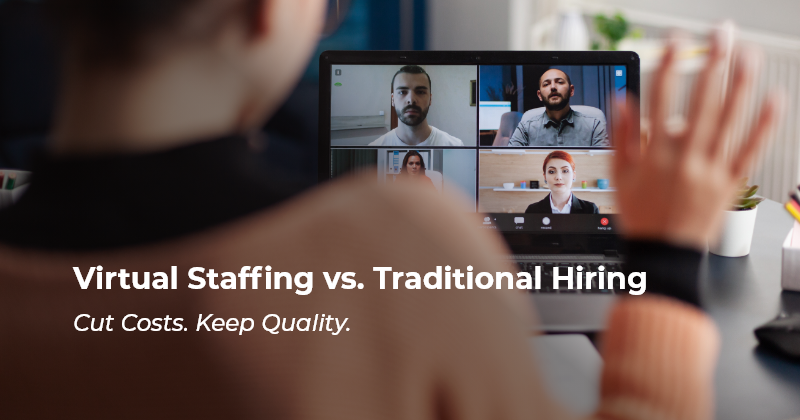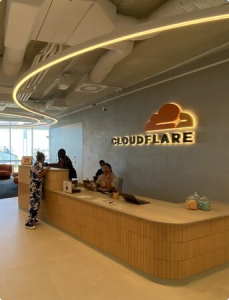Virtual Staffing vs. Traditional Hiring: Costs, Benefits & Future

As enterprises accelerate digital transformation, staffing models are evolving. Virtual staffing is no longer just a cost-saving measure — it’s a strategic enabler that helps organizations innovate faster, access niche skills globally, and stay competitive in uncertain markets.
In this blog, we’ll explore the key differences between virtual staffing and traditional hiring, breaking down the costs, benefits, and scenarios where virtual teams can deliver a real competitive advantage without sacrificing performance or control.
What’s the Difference?
Traditional hiring involves recruiting full-time, on-site staff — a process that typically requires extensive recruitment, onboarding, investment in office infrastructure, and long-term salary and benefits commitments.
In contrast, virtual staffing offers the flexibility to engage experienced remote professionals or entire teams for specific projects or tasks, without the added costs of maintaining in-house employees. These experts are often provided through a resource augmentation partner, like Claritus Consulting, giving you fast access to vetted talent that’s ready to contribute from day one.
Comparing Costs: How Virtual Staffing Cuts Expenses for IT Teams
With CFOs prioritizing agility and cost predictability, virtual staffing provides a variable cost model that aligns with modern financial strategies. Here’s how it compares:
- Recruitment: Traditional hiring means high costs for ads, agencies, and long interviews. Virtual staffing cuts this as your partner handles sourcing and vetting.
- Onboarding & Training: Full-time hires need weeks of training. Virtual professionals are project-ready, saving time and resources.
- Infrastructure: In-house teams require equipment, workstations, and software. Virtual staffing includes these, with no extra investment.
- Salaries & Benefits: Permanent staff add fixed costs like healthcare and perks. Virtual staff run on a flexible, pay-for-what-you-need model.
- Attrition & Turnover: Replacing staff means downtime and retraining. Virtual staffing providers ensure quick, disruption-free replacements.
Forward-looking providers are also leveraging AI to match talent with project requirements in days instead of weeks, further cutting recruitment costs. In fact, a recent Gartner study* found that organizations using virtual staffing solutions can reduce operational costs by up to 30%, especially in IT and development teams.
– Boosting Productivity and Speeding up Delivery
One of the biggest advantages of virtual staffing is the ability to get things moving fast. Virtual teams are highly skilled and industry-ready, eliminating lengthy onboarding. With AI-driven tools, they deliver faster, automate repetitive tasks, and free your team for high-value innovation.
You get:
- Faster project kick offs
- No delays from lengthy onboarding processes
- Around-the-clock progress, thanks to global time zone coverage
With Claritus’s IT Teams on Demand model, you gain instant access to the right talent, ready to integrate seamlessly, work efficiently, and help you meet tight deadlines without compromising on quality.
Flexibility and Scalability Exactly When You Need It with Resource Augmentation
In today’s fast-paced business world, being able to adapt quickly is key. That’s where virtual staffing really shines. It gives you the freedom to scale your team up or down as your project demands or market conditions change without the delays and complications of traditional hiring.
Unlike permanent employment, which often comes with fixed contracts and time consuming off boarding, virtual staffing makes it easy to
- Add extra support during busy periods
- React quickly to shifting priorities or market changes
- Expand into new regions without the cost or hassle of setting up local offices
This level of flexibility makes resource augmentation an ideal choice for businesses going through digital transformation or facing uncertain economic conditions.
Understanding the Risks and How to Stay Ahead of Them in Virtual Staffing Solutions
While virtual staffing solutions bring a lot of advantages, it’s important to be aware of the potential challenges and know how to manage them. With tightening global data regulations (such as GDPR updates, HIPAA in healthcare, or industry-specific compliance), ensuring your virtual teams operate within secure frameworks is non-negotiable.
The good news? With the right partner, these risks are easy to mitigate.
- Data Security & Compliance: Security is often the first concern with remote teams. That’s why it’s essential to work with professionals who follow strict data protection protocols. At Claritus, our virtual teams operate within robust, enterprise grade compliance frameworks to keep your systems and information safe.
- Time Zone & Communication Gaps: Coordinating work across different time zones can be challenging, but with the right tools, it becomes much easier. Solutions like Microsoft Teams and Azure DevOps help keep communication clear, track progress efficiently, and keep teams on the same page.
- Quality Assurance: Quality starts with the right people. That’s why partnering with a reliable provider is key. At Claritus, all talent is thoroughly vetted and monitored under strict Service Level Agreements (SLAs) to ensure they consistently deliver top notch results.
With the right engagement model, virtual teams can be just as effective — if not more — than traditional in-house teams.
When Is Virtual Staffing the Right Choice?
Traditional hiring isn’t always the most practical or efficient route. Virtual staffing adds value when:
- You need to kick off a project fast and can’t afford the delays of a lengthy hiring process
- You’re working with a limited or unpredictable budget and need flexible staffing options
- You’re building a Proof of Concept (PoC) or testing a pilot project before scaling
- You’re expanding into new markets and want to avoid the costs of setting up a local presence
In situations like these, partnering Claritus Consulting gives you immediate access to the right talent — plus the tools, processes, and oversight to ensure high performance, compliance, and value from day one.
Bottom Line
Virtual staffing isn’t just an alternative to traditional hiring — it’s the blueprint for the future workforce.
Ready to build a smarter, more agile workforce? Partner with Claritus Consulting for flexible virtual staffing solutions that scale with your business needs









